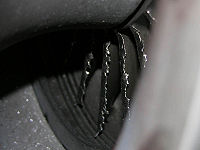
Photo from wikipedia
We modelled the effect of habitat composition and roads on the number and occurrence of moose ( L.) damage in Ostrobothnia and Lapland using a zero-inflated count model. Models were… Click to show full abstract
We modelled the effect of habitat composition and roads on the number and occurrence of moose ( L.) damage in Ostrobothnia and Lapland using a zero-inflated count model. Models were developed for 1 km, 25 km and 100 km landscapes consisting of equilateral rectangular grid cells. Count models predict the number of damage, i.e. the number of plantations and zero models the probability of a landscape being without damage for a given habitat composition. The number of moose damage in neighboring grid cells was a significant predictor in all models. The proportion of mature forest was the most frequent significant variable, and an increasing admixture of mature forests among plantations increased the number and occurrence of damage. The amount of all types of plantations was the second most common significant variable predicting increasing damage along with increasing amount of plantations. An increase in thinning forests as an admixture also increased damage in 1 km landscapes in both areas, whereas an increase in pine-dominated thinning forests in Lapland reduced the number of damage in 25 km landscapes. An increasing amount of inhabited areas in Ostrobothnia and the length of connecting roads in Lapland reduced the number of damage in 1 and 25 km landscapes. Differences in model variables between areas suggest that models of moose damage risk should be adjusted according to characteristics that are specific to the study area.Alces alces222222
Journal Title: Silva Fennica
Year Published: 2019
Link to full text (if available)
Share on Social Media: Sign Up to like & get
recommendations!